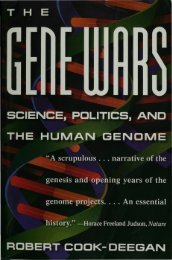Eugenics Record Office. BULLETIN No. 10A - DNA Patent Database ...
Eugenics Record Office. BULLETIN No. 10A - DNA Patent Database ...
Eugenics Record Office. BULLETIN No. 10A - DNA Patent Database ...
Create successful ePaper yourself
Turn your PDF publications into a flip-book with our unique Google optimized e-Paper software.
THE SCOPE OF THE COMMITTEE’S WORK. 29<br />
By direct heredity is meant the transmission of a trait or a quality<br />
that will, in spite of controlled environment, appear at some time in<br />
the course of development of the individual. Thus the extra digit in<br />
polydactylism appears early during the second month of gestation. In<br />
children destined to be brown-eyed, the brown iris pigment appears<br />
during the first few days after birth. <strong>No</strong>rmally, a child begins to shed<br />
his milk teeth at the age of about six years. With males, the beard<br />
appears in early manhood. Usually Huntington’s chorea appears in<br />
tainted individuals at the age of approximately 50 years. All of these<br />
are traits of direct heredity. In these, heredity is the primary factor,<br />
environment has but little to do with them.<br />
There is a second type of heredity, which might well be called<br />
“indirect heredity” or “heredity-diathesis,” “susceptibility” or “pre-<br />
disposition.” In this sort of heredity environment plays a much greater<br />
part in determining the human trait or condition than it plays in direct<br />
heredity, but even in such cases the exogenous forces are not all-im-<br />
portant. Heredity is as it were the foundation upon which environ-<br />
ment builds the trait. In such cases heredity, although a less powerful<br />
factor, is just as definite as with direct inheritance, and the end product<br />
is a composite of hereditary and extrinsic factors. Thus, people do<br />
not, biologically speaking, directly inherit tuberculosis and yet they<br />
inherit directly a constitutional make-up possibly both functional and<br />
chemical, as well as structural; that causes them to fall an easy prey<br />
to this disease. People do not inherit poisoning of the poison ivy ( Rhus<br />
toxicodendron ) type, still some persons are immune to the effects of<br />
this poison, while others readily become affected by it. Thus, in refer-<br />
ence to their susceptibility and immunity, there appears to be a chemical<br />
difference in persons which is directly hereditary, but it requires the<br />
presence of an exogenous agent, in addition to the innate lack of resist-<br />
ance, to cause the affection.<br />
Thirdly, there are many diseases and conditions in which the<br />
hereditary difference of people plays a very minor role or is entirely<br />
negligible as a causative factor, while environment plays the all-<br />
important part. Thus, everybody appears to be more or less sus-<br />
ceptible to “colds,” and possibly to the more infectious virulent infec-<br />
tious diseases such as rabies.<br />
There are thus all degrees of the influence of heredity in deter-<br />
mining a human condition. Let the following scale, beginning with<br />
absolutely no influence and ending with all influence, represent this<br />
fluctuation.



